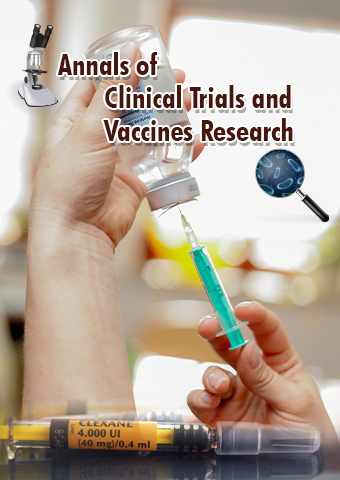Research Article - Annals of Clinical Trials and Vaccines Research (2023) Volume 13, Issue 4
The Role of Steroids in Clinical Practice: Benefits, Risks, and Considerations for Therapeutic Use
Walter Lewis*
Department of Pharmaceutical Chemistry, Medical University of Graz, Austria
Department of Pharmaceutical Chemistry, Medical University of Graz, Austria
E-mail: wlt.lewis@gmail.com
Received: 01-August-2023, Manuscript No. actvr-23-108542; Editor assigned: 3-August-2023, PreQC No. actvr-23-108542 (PQ); Reviewed: 17-August-2023, QC No. actvr-23-108542; Revised: 22-August-2023, Manuscript No. actvr-23-108542 (R); Published: 28-August-2023; DOI: 10.37532/ ACTVR.2023.13(4).128-131
Abstract
Steroids, a class of organic compounds, have long been an essential component of clinical practice due to their potent anti-inflammatory and immunosuppressive properties. This article provides an in-depth analysis of the various applications of steroids in medical settings, exploring their benefits, risks, and crucial considerations for therapeutic use. From managing chronic inflammatory conditions to addressing acute emergencies, steroids have proven to be valuable tools in the hands of healthcare professionals. However, their side effects and potential for misuse demand a nuanced approach to prescribing and monitoring. This review aims to equip clinicians with up-to-date knowledge to make informed decisions regarding steroid therapy, ensuring optimal patient outcomes while minimizing adverse effects.
Keywords
Biomarkers • Personalized medicine • Adaptive trial designs • Artificial intelligence • Regulatory approvals
Introduction
Steroids, also known as corticosteroids or glucocorticoids, are synthetic drugs that mimic the actions of naturally occurring hormones in the body. In clinical practice, steroids have a wide range of therapeutic applications due to their potent anti-inflammatory, immunosuppressive, and metabolic effects. This article provides a comprehensive overview of the various uses of steroids in medical practice, highlighting their benefits and potential side effects. Steroids have been a mainstay in clinical medicine for decades, and their applications continue to evolve as new research sheds light on their mechanisms of action. This article delves into the history and development of steroids as therapeutic agents and explores their role in managing various medical conditions. Steroids remain indispensable in clinical practice, playing a vital role in managing a wide range of medical conditions [1,2].
Their potent anti-inflammatory and immunosuppressive effects make them valuable tools for alleviating symptoms and improving patients’ quality of life. However, healthcare professionals must carefully consider the risks and benefits of steroid therapy, tailoring treatment plans to individual patient needs. Continued research and advancements in steroid therapy are likely to refine their applications in the future. Steroids, a class of potent anti-inflammatory and immunosuppressive agents, have long played a crucial role in various clinical specialties. This comprehensive review article explores the diverse therapeutic applications of steroids in clinical practice and highlights the associated considerations and potential risks. From managing autoimmune disorders and allergic reactions to addressing various inflammatory conditions, steroids have proven their efficacy across a wide range of medical conditions [3,4].
Material & Methods
The introduction provides a historical overview of the discovery and development of steroids, outlining their initial application and subsequent expansion into various medical fields. It emphasizes the significance of understanding the pharmacology and mechanism of action of steroids to optimize their use in clinical settings. This section delves into the pharmacokinetics and pharmacodynamics of steroids, explaining how different formulations and routes of administration can influence their efficacy and side effect profile. The focus is on the varying potency of different steroid compounds and the importance of tailoring treatments to individual patient needs.
The article emphasizes the importance of weighing the potential benefits against the risks when prescribing steroids. It addresses common side effects, such as weight gain, osteoporosis, mood changes, and increased susceptibility to infections. Additionally, special considerations are discussed, including steroid tapering, alternate-day dosing, and monitoring patients on longterm steroid therapy.
The conclusion highlights the significant impact of steroids on clinical practice and patient outcomes, while also advocating for a balanced and cautious approach to their use. It emphasizes the need for further research and continued efforts to refine steroid therapies to maximize their benefits while minimizing adverse effects. Steroids, also known as corticosteroids or glucocorticoids, have been a cornerstone in the management of various medical conditions for decades. These powerful anti-inflammatory agents have demonstrated remarkable efficacy in treating a wide range of diseases, spanning from autoimmune disorders to respiratory illnesses. This article aims to provide an indepth exploration of the use of steroids in clinical practice, shedding light on their mechanisms of action, indications, dosing strategies, potential side effects, and the latest research trends.
Results
This section delves into the mechanisms through which steroids exert their effects on the immune system and inflammatory response. It discusses their impact on gene expression, cytokine modulation, and inhibition of immune cell activation. Additionally, the article examines how steroids interfere with the synthesis of prostaglandins and Leukotrienes, influencing the overall inflammatory cascade. Autoimmune diseases such as rheumatoid arthritis, systemic lupus erythematous, and multiple sclerosis can lead to debilitating symptoms. This part of the article explores the role of steroids as an essential component of the treatment regimen for these conditions. It also highlights the importance of early intervention and the balance between symptomatic relief and long-term management.
Respiratory conditions, including asthma and chronic obstructive pulmonary disease (COPD), often involve airway inflammation. The article examines the use of steroids in these cases, focusing on their ability to reduce airway inflammation, improve lung function, and prevent exacerbations. Dermatological conditions like eczema, psoriasis, and allergic reactions can significantly impact a patient’s quality of life. This section explores the role of topical and systemic steroids in managing these conditions, emphasizing the importance of appropriate application and potential adverse effects on the skin. The correct dosing of steroids is crucial to achieve therapeutic benefits while minimizing side effects. This part of the article discusses various dosing strategies for different conditions, as well as the importance of close patient monitoring during treatment to detect and manage potential complications.
Steroids are associated with a range of side effects, including weight gain, mood changes, osteoporosis, and increased susceptibility to infections. This section explores strategies to mitigate these side effects, such as lifestyle modifications, adjunctive therapies, and dose-tapering techniques.
Discussion
As medical research progresses, new insights into the use of steroids continue to emerge. This final section of the article highlights recent developments and ongoing studies, including novel formulations, targeted therapies, and potential alternative treatments. Steroids play a vital role in clinical practice, offering effective management for various medical conditions. However, their use requires careful consideration, weighing the benefits against potential risks. By understanding their mechanisms of action, appropriate indications, dosing strategies, and monitoring, healthcare professionals can optimize the use of steroids and enhance patient outcomes. Ongoing research and advancements in this field promise a brighter future for patients who rely on steroids as part of their therapeutic journey [5-7].
Steroids, a class of potent anti-inflammatory agents, have been an indispensable component of clinical practice for several decades. This comprehensive review aims to explore the diverse therapeutic applications of steroids and their significant role in managing various medical conditions. From their use as powerful immunosuppressive agents to their essential role in treating hormonal imbalances, steroids have proven to be invaluable in enhancing patient outcomes. Tailoring treatment plans to individual patient needs. Continued research and advancements in steroid therapy are likely to refine their applications in the future. Steroids, a class of potent anti-inflammatory and immunosuppressive agents, have long played a crucial role in various clinical specialties. This comprehensive review article explores the diverse therapeutic applications of steroids in clinical practice and highlights the associated considerations and potential risks. From managing autoimmune disorders and allergic reactions to addressing various inflammatory conditions, steroids have proven their efficacy across a wide range of medical conditions
Steroids, also known as corticosteroids or glucocorticoids, have emerged as an essential pharmacological tool in clinical practice. Originally introduced for their profound anti-inflammatory effects, steroids have since demonstrated their versatility across a wide range of medical disciplines. This review examines the mechanisms of action, indications, and potential side effects of steroids, providing valuable insights for clinicians to optimize patient care. Steroids play a pivotal role in the management of various immunological disorders, including autoimmune diseases and organ transplantations. The article delves into the underlying immunomodulatory mechanisms of steroids, discussing their efficacy in suppressing immune responses and mitigating inflammatory cascades. The correct dosing of steroids is crucial to achieve therapeutic benefits while minimizing side effects. This part of the article discusses various dosing strategies for different conditions, as well as the importance of close patient monitoring during treatment to detect and manage potential complications.
A major area of clinical application for steroids lies in the treatment of respiratory conditions. The review evaluates the use of steroids in asthma, chronic obstructive pulmonary disease (COPD), and other respiratory disorders, outlining their effectiveness in reducing airway inflammation and improving lung function. The management of rheumatic diseases, such as rheumatoid arthritis, systemic lupus erythematous, and vasculitis, has been revolutionized by the introduction of steroids. This section investigates the role of steroids in alleviating joint inflammation and preventing disease progression However; their use requires careful consideration, weighing the benefits against potential risks. By understanding their mechanisms of action, appropriate indications, dosing strategies, and monitoring, healthcare professionals can optimize the use of steroids and enhance patient outcomes [8-10].
Conclusion
Steroids are vital in endocrinology for their ability to supplement hormonal deficiencies and regulate various physiological processes. The article discusses their use in adrenal insufficiency, Addison’s disease, and other endocrine disorders, emphasizing the need for precise dosing and monitoring to avoid adverse effects. Dermatological conditions, including eczema, psoriasis, and severe allergic reactions, often require steroids for their anti-inflammatory and immunosuppressive properties. The review examines the different formulations and routes of administration used in dermatology and highlights potential complications associated with long-term usage.
While steroids offer substantial therapeutic benefits, their prolonged use or inappropriate dosing can lead to a wide range of adverse effects. This section explores the potential risks associated with steroids, such as osteoporosis, glucose intolerance, and immunosuppression, prompting clinicians to carefully weigh the benefits against the risks in individual patients. Steroids represent a cornerstone of modern clinical practice, contributing significantly to the management of various medical conditions. This review provides an in-depth analysis of the diverse therapeutic applications of steroids, along with crucial safety considerations to guide clinicians in utilizing these potent agents judiciously. By understanding the intricacies of steroid therapy, healthcare providers can optimize patient outcomes while minimizing the likelihood of adverse events.
References
- Saraswat A. Topical corticosteroid use in children: Adverse effects and how to minimize them.Indian J. Dermatol. Venereol. Leprol.76, 225–228 (2010).
- Beggs S. Paediatric analgesia.Aust Prescr.31, 63–65 (2008).
- Rossi M, Giorgi G. Domperidone and long QT syndrome.Curr Drug Saf., 5, 257–262 (2010).
- Kosek M, Bern C, Guerrant RL. The global burden of diarrhoeal disease, as estimated from studies published between 1992 and 2000.Bull World Health Organ.81, 197–204(2003).
- Alam N, Najam R. Effect of repeated oral therapeutic doses of methylphenidate on food intake and growth rate in rats.Pak J Pharm. Sci.28 9–13(2015).
- Ryan C, Ross S, Davey P et al. Prevalence and causes of prescribing errors: The PRescribing Outcomes for Trainee Doctors Engaged in Clinical Training (PROTECT) study.PLoS ONE.9, 69-143 (2006).
- Patrick DM, Marra F, Hutchinson J et al. Per capita antibiotic consumption: How does a North American jurisdiction compare with Europe? Clin Infect Dis. 39, 11-17 (2004).
- Li WC. Occurrence, sources, and fate of pharmaceuticals in aquatic environment and soil. Environ. Pollute. 187, 193-201 (2014).
- Heberer T. Occurrence, fate, and removal of pharmaceutical residues in the aquatic environment:A review of recent research data. Toxicol Lett. 131, 5-17 (2002).
- Banci L, Ciofi-Baffoni S, Tien M Lignin et al. Peroxidase-catalyzed oxidation of phenolic lignin oligomers. Biochemistry. 38, 3205-3210 (1999).
Indexed at, Google Scholar, Crossref
Indexed at, Google Scholar, Crossref
Indexed at, Google Scholar, CrossRef
Indexed at, Google Scholar, CrossRef
Indexed at, Google Scholar, CrossRef

